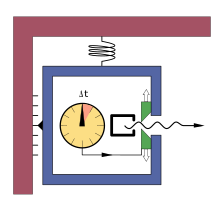Photon scale
The photon scale was invented by Albert Einstein as a thought experiment to show the incompleteness of quantum mechanics . According to quantum theory, the period at which a quantum particle leaves a certain space and the energy of this quantum particle cannot both be determined with arbitrary precision. This “uncertainty” is described in quantum theory by the Heisenberg uncertainty principle . Albert Einstein surprisingly presented this thought experiment to Niels Bohr at the Solvay Congress in 1930 .
Interestingly enough, the apparent contradiction between special relativity and quantum theory is canceled out by Albert Einstein's own general relativity theory .
description

A closed system that hangs on a spring balance contains a clock , a shutter controllable by the clock and a source of photons . The weight of the system is measured at the beginning of the experiment . Then the shutter controlled by the watch is opened for a short time so that electromagnetic energy can escape from the system in the form of a photon . One is then re- weighing performed.
Any amount of time is available for both weighings so that they can be carried out as precisely as required. With the decrease in mass , according to the special theory of relativity, the energy of the photon can in principle also be determined as precisely as desired using the relationship for the equivalence of mass and energy ( denote the speed of light ).
In addition, the shutter can be released as short as desired, so that both the point in time at which the photon left the system and its energy can in principle be determined as precisely as required. This initially contradicts Heisenberg's uncertainty principle, according to which the product of the energy and time difference cannot be arbitrarily small.
Resolution of the objection
Niels Bohr was able to resolve the contradiction a day later by applying the principle of Albert Einstein's general theory of relativity to the experiment: By reducing the mass of the system after leaving the photon, the spring of the balance pulls the system slightly upwards so that the The clock in the system is subject to time dilation , which is caused by the decrease in gravitational potential . The indeterminacy of the time measurement results in an uncertainty that corresponds in magnitude to the uncertainty predicted by Heisenberg's uncertainty principle.
literature
- Károly Simonyi: The cultural history of physics. From the beginnings till now. Harri Deutsch, Frankfurt am Main 2001, ISBN 3-8171-1651-9




